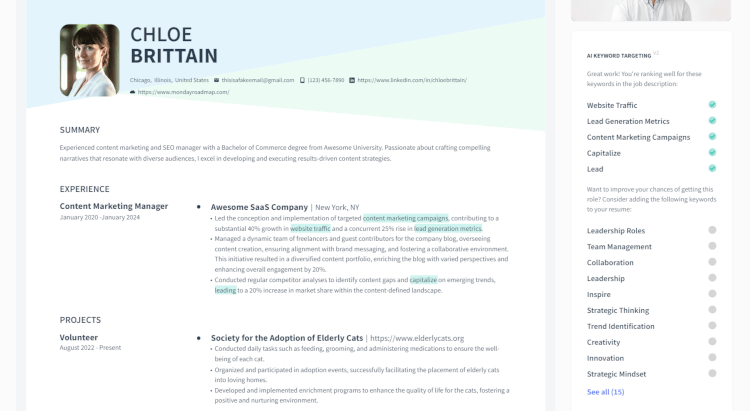101+ AI Statistics in 2024: The Present and Future of AI
Within the diverse realms of business, finance, technology, and academia, AI is shaping the present and future landscape in incredible ways. In this roundup of AI statistics from multiple top industry reports, we look at the current state and upcoming trends of AI technologies like machine learning, deep learning, and natural language processing.
We’ll also explore the status of AI adoption and investment across various sectors, backed by eye-opening figures that showcase the global AI market’s dynamic growth.
Sources are linked at the bottom of the article.
Top 10 AI statistics (editor’s picks)
- The global AI market, valued at nearly $100 billion in 2023, is projected to grow 20 times larger by 2030, reaching nearly $2 trillion. (Statista)
- In 2022, the global AI market was estimated at $119.78 billion, and projections suggest it will reach $1,591.03 billion by 2030, with a compound annual growth rate of 38.1% from 2022 to 2030. (Precedence Research)
- Generative AI will become a $1.3 trillion market by 2032, up from a market size of only $40 billion in 2022. Compound annual growth rate is predicted at 42%. (Bloomberg Intelligence)
- U.S. government AI-related contract spending continues to rise in 2023, having increased approximately 2.5 times since 2017. (Stanford)
- There were 110 AI-related legal cases in U.S. state and federal courts in 2022 – almost seven times more than in 2016. (Stanford)
- In a 2023 study, 65% of business leaders agreed that AI will rival the Industrial Revolution in terms of its impact on productivity. (HubSpot)
- A notable shift is happening in the organic search landscape, with 65% of consumers in 2023 stating they plan to use ChatGPT instead of traditional search engines. (Forbes)
- 57% of participants in a 2023 survey predicted that by 2024, most of the software they use will come with built-in AI or automation features. (HubSpot)
- By 2025, AI software alone is expected to generate revenues of almost $100 billion worldwide. (Omdia)
- Recent studies show that LLMs (large language models) can currently automate around 15% of tasks. Research suggests that this capability may extend to 50% of tasks when paired with applications that address issues like factual inaccuracies. (WEF)
Artificial intelligence market size and growth rate
Top industry reports show that despite fluctuations, the global AI market is set for remarkable growth, impacting various industries. The U.S. leads in AI investment, securing a significant share and dominating in newly funded AI companies.
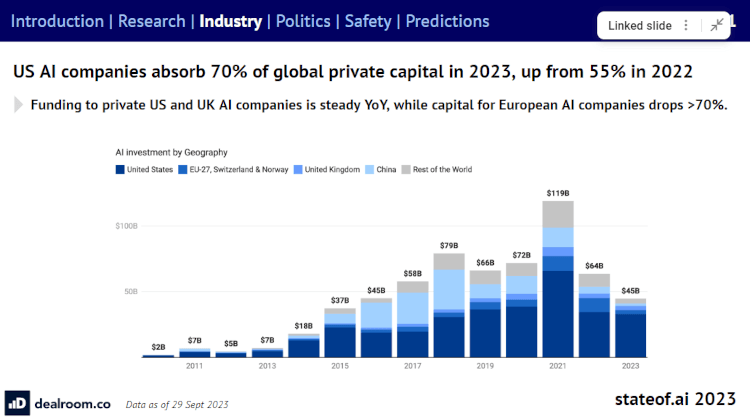
Let’s look at some of the top statistics:
- In 2022, the global AI market was estimated at $119.78 billion, and projections suggest it will reach $1,591.03 billion by 2030, driven by a robust compound annual growth rate of 38.1% from 2022 to 2030. (Precedence Research)
- In 2023, U.S. AI companies attracted a substantial 70% of global private capital, marking a notable increase from the 55% seen in 2022. (State of AI Report)
- Globally, enterprise software, fintech, and healthcare were the top recipients of AI-related investments in 2023. (State of AI Report)
- In 2023, AI companies accounted for 24% of all corporate venture capital investments. During the same year, corporate investments shifted toward GenAI, with a 50% reduction in funding for non-AI companies compared to the previous year, while AI investments remained relatively stable at around $22 billion, down from $29 billion in 2022. (State of AI Report)
- In 2023, GenAI funding saw a significant surge, reaching $18 billion in global VC investment, compared to $3.9 billion the previous year. (State of AI Report)
- In 2022, global AI private investment totaled $91.9 billion, marking a 26.7% decrease from 2021. Despite this annual decline, AI investment has grown significantly over the last decade, with 2022’s private investment being 18 times greater than that of 2013. (Stanford)
- Also in 2022, medical and healthcare received the highest AI investment at $6.1 billion, followed by data management, processing, and cloud at $5.9 billion, and fintech at $5.5 billion. (Stanford)
- In 2022, the United States maintained its global leadership in AI investment, securing $47.4 billion, approximately 3.5 times more than China’s $13.4 billion – the second-highest investment globally. The U.S. also dominated in newly funded AI companies, surpassing the combined numbers of the EU and UK by 1.9 times and China by 3.4 times. (Stanford)
- The global AI market, valued at nearly $100 billion, is projected to grow 20 times larger by 2030, reaching nearly $2 trillion. The market encompasses diverse industries such as supply chains, marketing, product manufacturing, research, and analysis. Major trends include the integration of chatbots, image-generating AI, and mobile applications. (Statista)
Artificial intelligence growth chart
The following chart from Statista shows AI market size in millions of US dollars from 2021 to 2030 (projected).
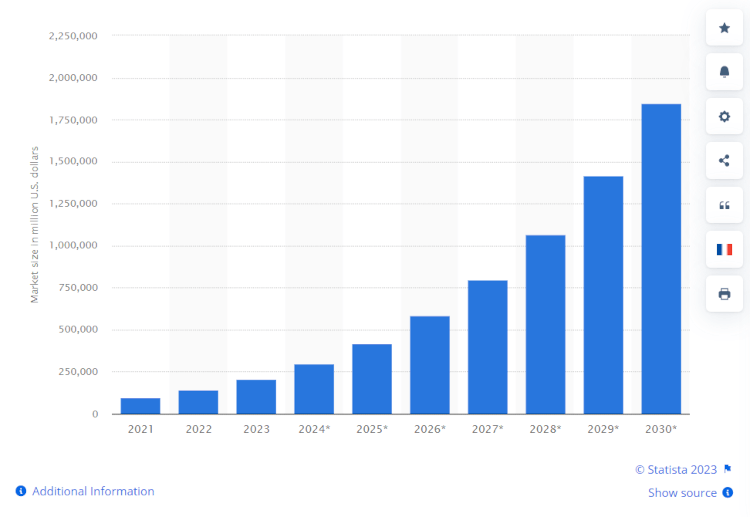
AI sentiment
While AI sentiment is bullish in the business and finance communities, sentiment among the general public and NLP researchers tends to vary.
According to a Stanford sample of surveyed Americans, 31% of those who felt excited about AI felt it had the potential to improve life and society, while 13% predicted it would help them save time and improve efficiency.
On the flip side, of the participants who expressed concern, 19% were worried about job loss; 16% were concerned about surveillance, hacking, and digital privacy; and 12% felt AI would contribute to a lack of human connection.
Meanwhile, a Stanford survey of NLP researchers revealed that 77% believe private AI firms wield too much influence, 41% advocate for NLP regulation, and 73% anticipate AI’s potential for revolutionary societal change.
Impact of AI on business
Studies show that adoption of AI technology gives businesses a competitive advantage, both in terms of improved business strategy and operations. In this section, we cover the adoption of AI systems across industries. We also look at AI efficiency statistics plus other benefits and challenges of adopting AI solutions.
Artificial intelligence usage statistics
How many people use AI?
Industry studies found that AI is widely used in workplaces, both openly and secretly. Many business professionals – especially in areas like marketing, sales, and customer support – use AI or automation in their roles. GenAI has become especially popular, with a significant number of respondents using it regularly, particularly within the tech sector.
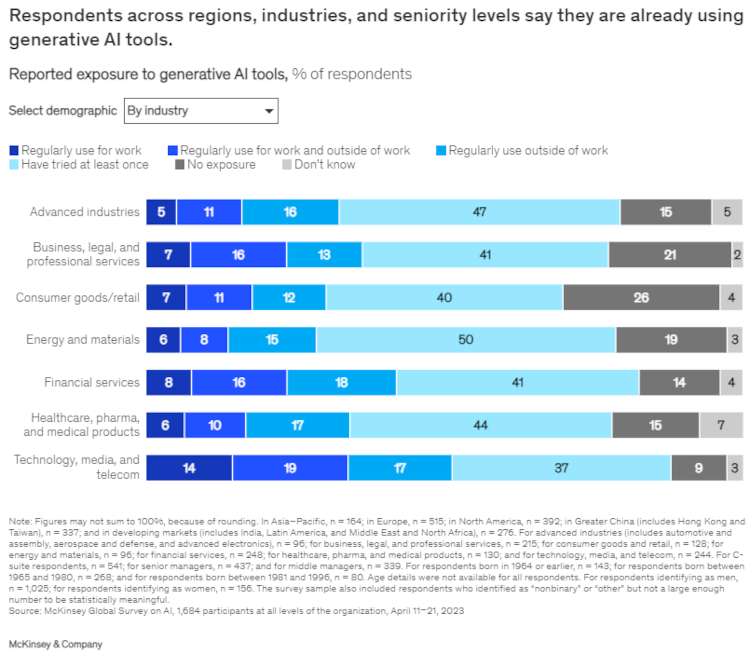
- AI use in the workplace, both open and in secret, is widespread. In one study, 54% of the respondents that report using AI at work do so at companies that allow it. In the same study, 34.4% of respondents admitted to secretly using AI at work, although 57% of this segment claims they’re using it within company policy. (Retool)
- One in five business professionals use AI or automation, with higher usage rates in fields like blogging/SEO (54% of survey participants), marketing (35%), sales (24%), and customer support (18%). (HubSpot)
- According to a McKinsey study, 79% percent of all respondents (across regions, industries, and seniority levels) have some exposure to GenAI, whether at or outside of work. 22% regularly use it for work, with the highest usage in the technology sector and among North American respondents. (McKinsey)
How many companies have adopted AI?
The studies we looked at indicate that more than half of companies are using AI as of 2023 – especially GenAI. A majority of companies are interested in AI and plan to invest in AI technologies in the next few years if they haven’t already.
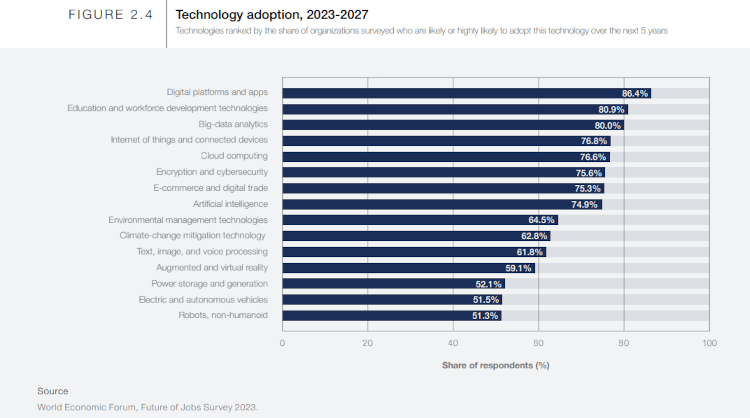
- Currently, 55% of organizations have adopted AI, though less than a third have implemented it across more than one business function. The top two functions that businesses most often report AI adoption are product and service development and service operations. (McKinsey)
- One-third of respondents note regular use of GenAI in their organizations in at least one business function, representing 60% of those with reported AI adoption. Additionally, 40% of those reporting AI adoption state their companies expect to increase overall AI investment due to recent developments in generative AI, and 28% already have generative AI on their board’s agenda. (McKinsey)
- In a 2023 study by Retool, a majority of participants surveyed (77.1%) say their companies have made at least some effort to adopt AI, but around 48.9% stated these efforts are ad-hoc use cases or in their early stages. Notably, 15.7% haven’t started yet. (Retool)
- A 2023 WEF report found that over 75% of companies plan to adopt the technologies of big data, cloud computing, and AI by 2027. (WEF)
- WEF found that big data analytics is the third most likely overall technology for companies to adopt by 2027, with 80% of companies planning deeper integration and 75% planning to introduce AI technologies like machine learning and neural networks. (WEF)
- Thanks to the growing capabilities and availability of generative AI, 72% of companies plan significant annual increases in AI investment over the next three years. (Scale)
According to a study by Scale, respondents across all industries are planning to increase their AI budget over the next three years. Top industries include:
- Insurance: 80%
- Logistics and supply chain: 79%
- Financial services: 77%
- Healthcare and life sciences: 75%
- Retail and ecommerce: 74%
Forbes also found that business owners are optimistic about AI benefits in 2023, with 64% expecting AI to improve customer relationships and increase productivity and 60% predicting it will drive sales growth.
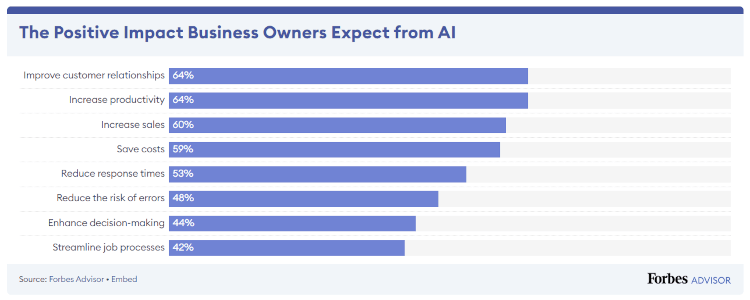
Respondents also see AI as an asset for:
- Improving decision-making (44%)
- Decreasing response times (53%)
- Avoiding mistakes (48%)
- Cutting costs (59%)
- Streamlining job processes (42%)
AI ROI statistics
Multiple industry studies show that AI has been good for business across the board, linking AI adoption to revenue growth, cost savings, and increased worker productivity across functions. Survey participants also noted benefits such as new product development, better customer experiences, and streamlined cross-functional collaboration.
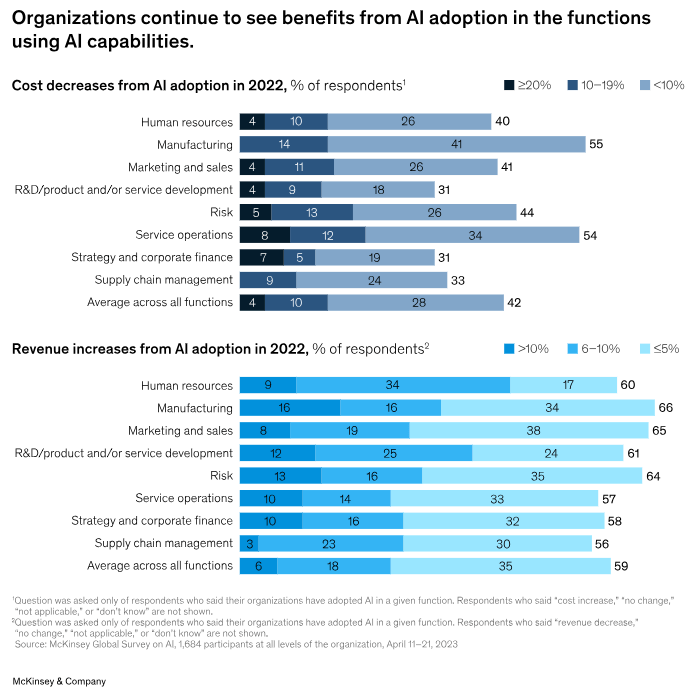
- 62% of business leaders have invested in AI for employee use, with 71% reporting a positive ROI and 72% noting increased worker productivity. (HubSpot)
- The majority of organizations using AI report revenue increases within each business function that uses AI. Over two-thirds plan to increase AI investment in the next three years. (McKinsey)
A study by Scale discovered that companies adopting AI benefit in various ways:
- 89% develop new products or services
- 78% enhance customer experiences
- 76% achieve better cross-functional collaboration
Similarly, a 2023 industry report by Stanford University found that adopting AI leads to cost decreases and revenue increases for organizations.
How are businesses using AI?
Industry reports found that businesses are using AI for diverse purposes, with a primary focus on improving customer experience, enhancing operational efficiency, and boosting profitability.
Key applications include customer service, cybersecurity, digital personal assistants, among many others. Additionally, 2023 saw a noticeable shift in focus from traditional computer vision to LLMs and generative AI.
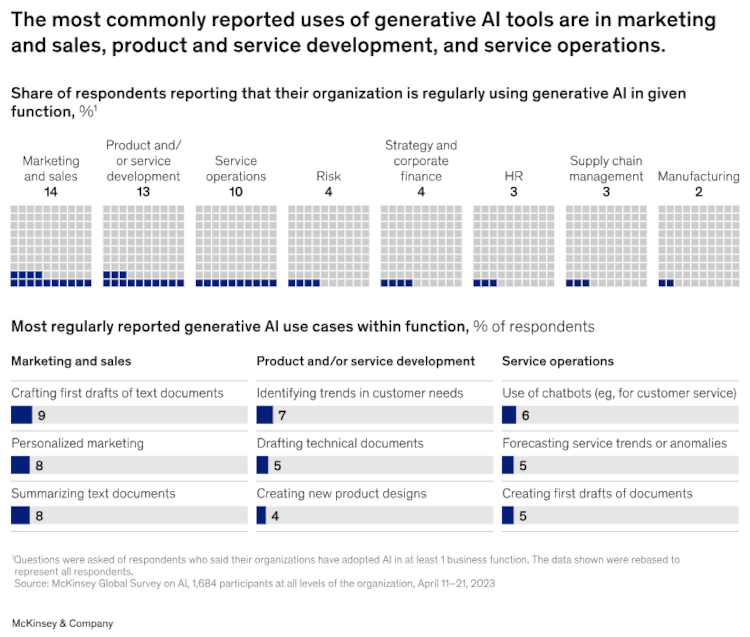
- 61% of companies use AI to improve customer experience, 56% for operational efficiency, and 50% to boost profitability. (Scale)
- The top business functions using GenAI tools are marketing, sales, product development, and service operations like customer care and back-office support. (McKinsey)
Forbes found that companies use AI in diverse ways. The top uses they reported in 2023 include:
- Customer service (56% of survey participants)
- Cybersecurity and fraud management (51%)
- Digital personal assistants (47%)
- Customer relationship management (46%)
- Inventory management (40%)
- Content production (35%)
- Product recommendations (33%)
- Accounting (30%)
- Supply chain operations (30%)
- Recruitment and talent sourcing (26%)
- Audience segmentation (24%)
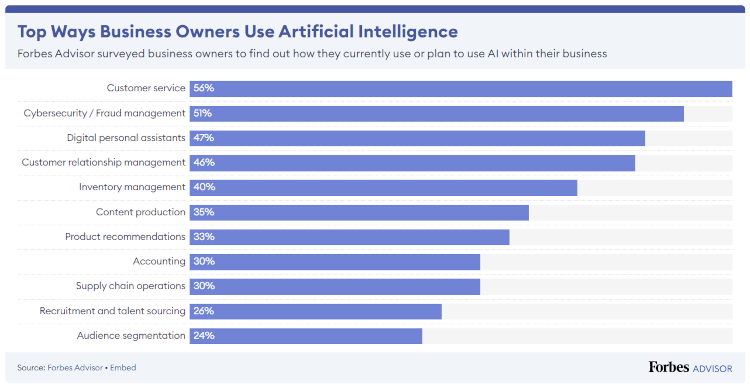
In 2023 as compared to 2022, there’s a trend of companies shifting focus from traditional computer vision to LLMs and generative AI. Of those heavily investing in AI, 52% prioritize LLMs, 36% generative visual models, and 30% computer vision applications. (Scale)
AI trends and use cases by industry
How do specific industries implement AI? Here’s what the studies show:
Marketing and social media
According to a study by HubSpot, 35% of marketers currently incorporate AI and automation in their roles, with AI usage rising to 54% among bloggers and SEO specialists.
AI tools save the average marketing employee almost 2.5 hours daily on routine tasks, effectively doubling their productivity. This translates to a significant 12.5 hours reclaimed per week, providing an extra 25-26 working days annually.
On average, marketers who use generative AI writing tools save more than three hours per piece of content.
63% of marketers who use these tools state that the AI-assisted content performs better than manually written content. An overwhelming 89% of marketers believe that AI enhances the overall quality of their content.
When surveyed on the marketing content types that AI tools are most helpful for creating, respondents indicated a preference for social media posts (58%), product descriptions (50%), emails (43%), images (36%), and blog posts (35%).
Use cases for GenAI tools were equally diverse among marketers, with 48% using it for research, 45% for content creation, and another 45% for analyzing and reporting on data. Additionally, 32% use generative AI as a learning tool, showcasing its versatility in various marketing functions.
Sales
Sales professionals who use AI tools save a significant two hours and 15 minutes every day, as reported by HubSpot.
The study found that the top three use cases for AI and automation among sales professionals include automating manual tasks (35% of survey participants), providing data-driven insights (34%), and assisting in the creation of sales content and prospect outreach messages (31%).
An impressive 85% of survey participants claim it enhances their prospecting efforts, with 79% able to dedicate more time to selling and 72% citing faster rapport building.
In terms of generative AI, sales professionals noted its usefulness in content creation (18%), prospect outreach (16%), research (16%), learning (15%), and data analysis/reporting (14%).
The findings of the HubSpot study underscore the diverse ways in which AI is contributing to marketing, sales, and customer service processes.
Customer service
The same HubSpot study noted above found that customer service professionals save over two hours daily using generative AI for quick responses. 84% of reps find that AI makes responding to tickets easier, while 64% say generative AI enhances personalization.
The top benefits of using AI and automation noted by support agents include 24/7 availability (36% of respondents), time savings/task automation (31%), faster response to service requests/reduced handling time (30%), and handling smaller tasks, allowing more time for complex issues (28%).
61% of customer service professionals anticipate widespread AI/automation use among reps by 2024.
Creative professions
A survey by Adobe discovered that many creative professionals, rather than fearing AI’s impact, have begun to embrace generative AI tools, such as AI art generators, in their work. Usage rates are as follows:
- ChatGPT (48%)
- DALL-E (34%)
- Runway (30%)
- Stable Diffusion (27%)
- Midjourney (25%)
In fact, only 19% of the creative professionals Adobe interviewed hadn’t used generative AI tools for work.
What’s more, even if they haven’t yet used GenAI, most creative professionals plan to use it at some point (71% in professional projects and 59% in personal work). Adoption rates varied widely among roles, as seen below:
- UI/UX designers (91%)
- Web/app designers/developers (87%)
- Professional video/audio/animators (80%)
- IT professionals/software developers (77%)
- Professional photographers (71%)
- Graphic designers/illustrators (69%)
- Other creative designers (63%)
- Print designers/publishers (45%)
Creative professionals also anticipate that GenAI, when harnessed effectively, will be useful for exploring new mediums (51% of survey participants), creating higher quality work (46%), and differentiating their work (35%).
Impact of AI on jobs and employment
Multiple AI and job market studies underscore the increasing demand for AI skills in the job market, reflecting an AI-focused trend in hiring preferences and educational specializations. While job displacement is a real concern, some studies predict net-positive job growth due to the proliferation of new AI-related roles.
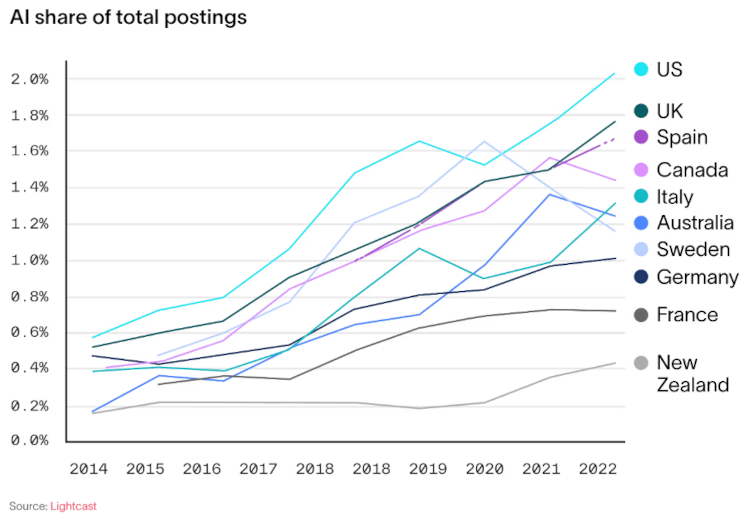
Here are some of the top statistics we found:
- Employer demand for AI skills is rising across all U.S. industries (except agriculture, forestry, fishing, and hunting). On average, AI-related job postings increased from 1.7% in 2021 to 1.9% in 2022. (Stanford)
- In 2021, 19.1% of new computer science PhD graduates specialized in AI, up from 14.9% in 2020 and 10.2% in 2010. (Stanford)
- The roles organizations are hiring for AI support are evolving. Data engineers, machine learning engineers, and AI data scientists are the most sought-after roles in 2023. However, the hiring of AI-related software engineers has decreased from 39% in the previous year down to 28%. Thanks to the trend toward GenAI, new roles in prompt engineering are emerging, with 7% of organizations that have adopted AI hiring for this skill. (McKinsey)
- Despite some predicting that GenAI will be the end of programming as a career, Lightcast, a global leader in labor market analytics, predicts that candidates with expertise in AI tools and developers who build them will be in high demand in the coming years. (Lightcast)
- In 2022, the US, UK, and Spain had the highest percentage of AI jobs. (Lightcast)
- The fastest-growing specialized skill in 2022 was machine learning operations. (Lightcast)
- Demand for AI and related skills has significantly increased globally, particularly in the US and UK. Since 2014, AI job postings have more than tripled in the US, UK, and Canada. (Lightcast)
- In a 2023 Forbes survey of 600 business owners, about 33% of participants were concerned that AI implementation could lead to a reduction in the human workforce. This concern was shared by 77% of consumers. (Forbes)
- AI and machine learning specialists are the fastest-growing jobs in 2023, followed by sustainability specialists, business intelligence analysts, and information security analysts. (WEF)
- According to a 2023 WEF study, many companies predict that AI will result in job displacement within their organizations, offset by growth elsewhere, resulting in a net positive. (WEF)
- In multiple recent Future of Jobs reports conducted by WEF, emerging roles include data analysts/scientists, AI and machine learning specialists, and digital transformation specialists. Declining roles include data entry clerks, executive and administrative secretaries, and accounting, bookkeeping, and payroll clerks. (WEF)
- Demand for experts in AI and machine learning is projected to increase by 40%, or 1 million jobs, due to increased usage driving industry transformation. (WEF)
- Big-data analytics is predicted to create jobs, with 65% of survey participants expecting labor market growth and only 7% predicting contraction. Specialized roles in AI and big data are predicted to grow by 30-35%. (WEF)
Of note, we’ve also been seeing a proliferation of job search-related generative AI tools, such as AI resume builders and headshot generators.
AI and the legal landscape
Studies show that the legal and legislative landscape is adapting to the rise of AI. Stanford reported that in 2022, there was a significant increase in the passage of AI bills in the U.S., with 10% of federal bills and 35% of state-level bills becoming law. This marked a substantial jump from the 2% federal passage rate in 2021.
According to the same Stanford study, the legal domain also witnessed a notable shift, with 110 AI-related legal cases in U.S. state and federal courts in 2022 – almost seven times more than in 2016. Most of these cases revolved around civil, intellectual property, and contract law.
Generative AI and ChatGPT statistics
ChatGPT played a major role in ushering in the current era of GenAI, reaching over 1 million users within just five days of its launch on November 30, 2022. Only two months later, in January 2023, the app reached almost 100 million monthly active users, making it the fastest-growing consumer Internet app in history.
To put this feat in perspective, TikTok took about nine months to hit the 100 million user mark, while Instagram took two and a half years. (Remarkably, Instagram Threads recently surpassed ChatGPT’s record, reaching over a million users in an hour and 100 million users in two days.)
Despite these incredible stats, 55% of surveyed U.S. adults reported not having heard of ChatGPT as of February 2023, according to Statista.
- Perhaps unsurprisingly, a recent MIT study found that ChatGPT makes writing-related tasks more efficient. The study demonstrated that for “mid-level professional writing,” those using ChatGPT took 40% less time, and the quality of their output was found to be 18% better compared to the control group. (State of AI Report)
- A significant majority of business owners are optimistic about the business potential of ChatGPT, with 97% identifying at least one way it will help their operations. (Forbes)
- Generative AI will become a $1.3 trillion market by 2032, up from a market size of only $40 billion in 2022. Growth rate is predicted at a CAGR of 42%. (Bloomberg Intelligence)
- The increasing demand for GenAI products could create $280 billion worth of new software revenue. (Bloomberg Intelligence)
- Key players in the generative AI market are Amazon Web Services, Microsoft, Google, and Nvidia. (Bloomberg Intelligence)
- Respectively, the biggest incremental revenue drivers will be GenAI infrastructure as a service used for training LLMs ($247 billion by 2032), digital ads powered by GenAI ($192 billion), and specialized GenAI assistant software ($89 billion). (Bloomberg Intelligence)
- In terms of hardware, the biggest revenue drivers in GenAI will be AI servers ($132 billion), AI storage ($93 billion), computer vision products ($61 billion), and conversational AI devices ($108 billion). (Bloomberg Intelligence)
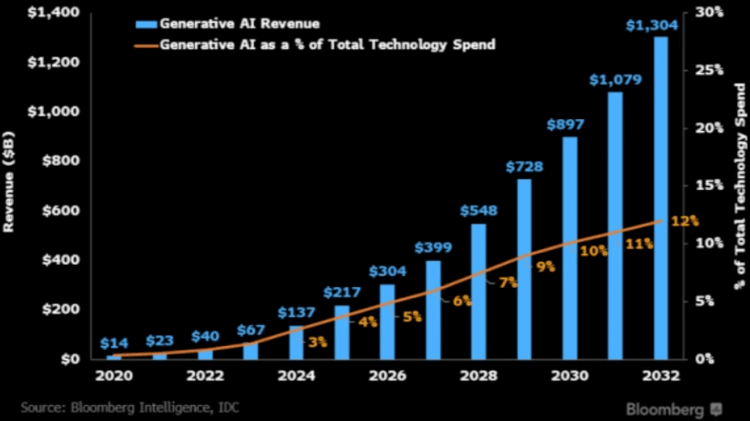
Sources: Recommended AI studies and industry reports
- Precedence Research
- Bloomberg Intelligence
- Hubspot State of AI Report
- Forbes Advisor survey
- Statista
- Stanford University AI Index Report 2023
- World Economic Forum – The Future of Jobs Report 2023
- State of AI Report 2023
- Retool – State of AI 2023
- McKinsey Global Survey on AI
- Scale 2023 AI Readiness Report
- Adobe
- Lightcast 2023 Global Talent Playbook
- Omdia
Current state and future of AI: FAQ
How fast is artificial intelligence growing?
Precedence Research estimated the global AI market at $119.78 billion in 2022, with projections suggesting it will reach $1,591.03 billion by 2030. This equates to a compound annual growth rate of 38.1%
Can AI replace humans?
The role of AI in replacing humans is a nuanced discussion. While AI excels in certain tasks, the complex nature of human capabilities and emotional intelligence makes complete replacement unlikely. Instead, future-of-work studies by companies like WEF and Lightcast show that AI is likely to redefine certain job roles rather than displacing humans entirely.
Can AI take over the world?
Whether or not AI can take over the world is a topic that is hotly debated among AI researchers and the broader public. Current AI capabilities suggest we are a long way off yet from artificial general intelligence (AGI). That said, ethical AI development and the implementation of safeguards remains essential to preventing the misuse of AI technology.
Wrapping up
While the ultimate impact of AI – positive or negative – on society, the global economy, and the environment remains to be seen, one thing is certain: AI will reshape how we live, work, and interact with the world.
The current AI statistics paint a vivid picture of the technology’s widespread adoption and transformative impact across industries. Beyond the numbers, these trends tell a story of AI’s role as a key player across domains for the foreseeable future, forecasting its continued impact on individuals and the global market.

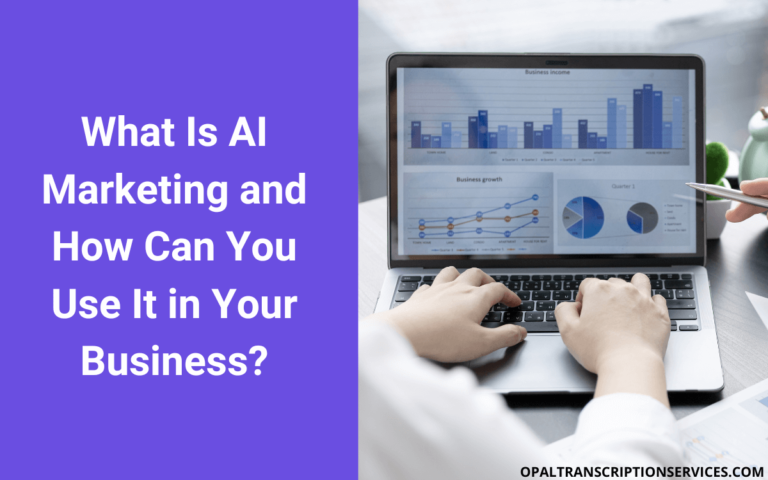
![Aragon AI Review [2024]: I Tried this AI Headshot Generator](https://www.mondayroadmap.com/wp-content/uploads/aragon-my-results-1-750px.png)

